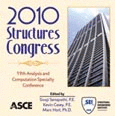Experimental and Analytical Assessment on Progressive Collapse Potential of Two Actual Steel Frame Buildings
Publication: Structures Congress 2010
Abstract
Progressive collapse can be defined as a chain reaction of failure initiated by loss of one or a few supporting elements due to manmade or natural hazards. As a result of increasing catastrophic events in recent years, the prevention of progressive collapse is increasingly becoming a requirement in building design and analysis. Many approaches have been proposed to prevent or minimize the risk of progressive collapse in new or existing buildings. Among a number of building codes, standards and design guidelines for progressive collapse, General Services Administration (GSA, [2]) and Department of Defense (DoD, [3]) address progressive collapse mitigation explicitly. They provide quantifiable and enforceable procedures to resist progressive collapse. Over the last decade, extensive studies have been performed to improve the design of buildings against progressive collapse by modifying the design codes, as well as to evaluate the progressive collapse potential of existing or new buildings by computer modelling and experiments. Very limited or no research, however, has been carried out by physically testing an actual full-scale steel building for the progressive collapse analysis. In this study, progressive collapse performance of two existing buildings was investigated through both experimental testing and computational analysis. Each building was tested by physically removing four first story perimeter columns prior to building's scheduled demolition to simulate the sudden column removals that leads to progressive collapse. Progressive collapse resistance of each building was investigated using the commercially available computer program, SAP2000 [4], and following the GSA guidelines. Two different analysis procedures were evaluated for their effectiveness in modeling progressive collapse scenarios; linear static and nonlinear dynamic procedures. Two- and three-dimensional models of steel frame buildings were developed to analyze the progressive collapse response. Differences and implications of each model and analysis are discussed. The strain values recorded in the field were compared with the results from a computer model of each building. It was expected that the field experiments and analytical studies can provide both practical and fundamental information on the collapse response of an existing building with a regular structural configuration.
Get full access to this article
View all available purchase options and get full access to this chapter.
Information & Authors
Information
Published In
Copyright
© 2010 American Society of Civil Engineers.
History
Published online: Apr 26, 2012
ASCE Technical Topics:
- Building design
- Buildings
- Computer models
- Design (by type)
- Engineering fundamentals
- Failure modes
- Forensic engineering
- Frames
- Material failures
- Materials characterization
- Materials engineering
- Models (by type)
- Progressive collapse
- Steel frames
- Steel structures
- Structural engineering
- Structural failures
- Structural members
- Structural systems
- Structures (by type)
Authors
Metrics & Citations
Metrics
Citations
Download citation
If you have the appropriate software installed, you can download article citation data to the citation manager of your choice. Simply select your manager software from the list below and click Download.
